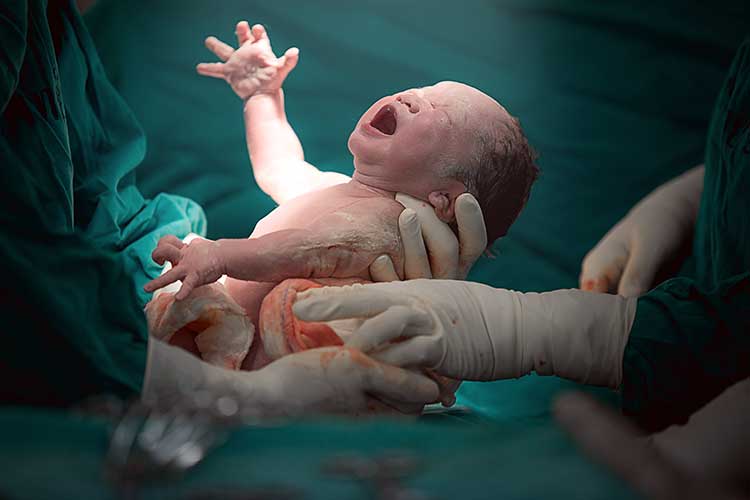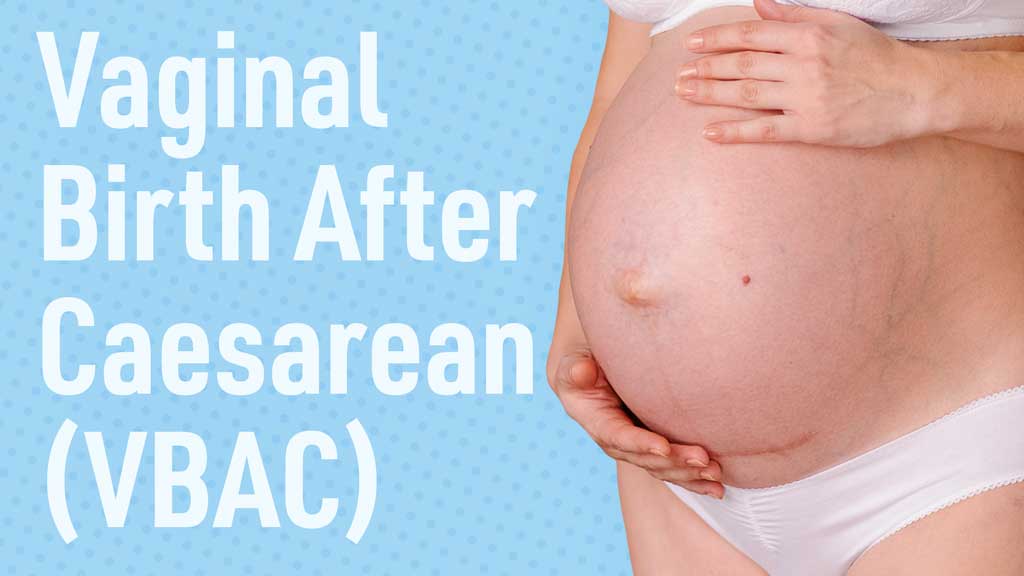In days gone by, the adage ‘once a caesarean, always a caesarean’ carried some truth to it (Reif et al. 2016).
Today, however, with careful management, vaginal birth after caesarean birth (VBAC) is generally considered to be safe.
Parents and midwives must weigh up the advantages and disadvantages of each mode of delivery, as each choice carries with it different risks and benefits.
Vaginal Birth After Caesarean
Those who have already experienced a successful vaginal birth, who maintain a healthy weight, and who go into spontaneous labour generally have a good chance of a successful natural birth after caesarean birth (Tommy’s 2021).
Benefits of Vaginal Birth After Caesarean
VBAC has many benefits for both parent and baby, especially as it allows for early physical and emotional contact. Other important advantages include:
- Lower risk of certain complications such as infections or blood clots
- Less abdominal pain post-delivery
- Shorter recovery time and hospital stay
- Sooner skin-to-skin contact post-delivery
- Lower risk of complications during future pregnancies
- Lower risk of neonatal respiratory problems
- Increased parental satisfaction in achieving a vaginal birth.
(Pregnancy Birth and Baby 2023; Raising Children Network 2021)
Disadvantages of Vaginal Birth After Caesarean

About 1 in 4 patients attempting VBAC will need an emergency caesarean birth, compared to 1 in 10 among those who previously delivered vaginally (Tommy’s 2021). Emergency caesarean birth has been found to carry a higher risk of complications than an elective repeat caesarean section (Pregnancy Birth and Baby 2023).
Disadvantages aren’t only limited to the increased risk of emergency surgery. They also include the potential for uterine scar rupture, which occurs approximately 5 to 7 times out of every 1000 attempts at VBAC (Pregnancy Birth and Baby 2023).
Contraindications to Vaginal Birth After Caesarean
VBAC is not a suitable or safe mode of delivery for all births, and there are times when a planned caesarean birth remains the safest mode of delivery.
In some circumstances, it’s clear before the onset of labour that an elective caesarean delivery is the safest choice, for example, in the case of:
- Maternal history of three or more previous caesarean deliveries
- Previous rupture of the uterus
- High uterine incision (classical caesarean)
- Previous uterine surgery, for example, removal of fibroids
- The patient has other pregnancy complications that require a caesarean birth.
(SCV 2018; Habak & Kole 2023)
Other absolute contraindications to vaginal birth can also apply regardless of the presence or absence of a scar, for example, the presence of placenta praevia or previous uterine rupture (Pregnancy Birth and Baby 2023).
The success rate of vaginal birth after a previous caesarean birth appears to be between 29 and 82%, although the percentage of successful VBAC cases falls with increasing maternal age (SCV 2018). Other factors that are thought to lower the chances of successful VBAC include:
- Maternal BMI > 30
- A short interval (<18 months) between the current pregnancy and previous caesarean birth
- Fetal macrosomia with a birth weight of > 4000 g
- Post-dates onset of labour.
(SCV 2018)
By contrast, higher multiparity has been shown to increase the likelihood of successful vaginal birth and is associated with a decreased risk of uterine rupture (Reif et al. 2016).
Antenatal Counselling
Before coming to a final decision about the preferred mode of birth, antenatal counselling supported by an information leaflet should be offered, and key points documented in the patient’s notes. The use of checklists may also be helpful as a means of ensuring informed consent and shared decision-making for patients undergoing VBAC (RCOG 2015).
Sys et al. (2021) have identified 34 different factors that can influence the preferred method of delivery. Key themes include:
- Recommendations from medical staff
- Desire to experience natural childbirth
- Easier and faster recovery
- Fear of pain
- A desire for predictability, comfort, and control
- A belief that caesarean birth is safer.

Bonzon et al. (2017) echo these findings, suggesting that many people feel unsure about the best mode of birth. It’s this group of patients, in particular, who benefit most from access to midwifery support to help them clarify their feelings and birthing preferences.
Research conducted by Foureur et al. (2017) highlights the importance of continuity of care for those considering VBAC. This, along with recognizing the value of trust and positive relationships, can go a long way in helping each individual patient evaluate the relative risks and benefits of different modes of delivery. That said, a common criticism voiced by patients is that they are often given conflicting and sometimes contradictory information by different professionals that can lead to a ‘wait and see’ approach, which, in turn, can generate further uncertainty and anxiety.
Reif et al. (2016) summarize many of the concerns surrounding VBAC by suggesting patients be informed that:
- The success rate for VBAC is between 29 and 82%
- A successful vaginal birth is associated with the lowest rate of complications
- Occasionally, in the event of unsuccessful vaginal delivery, an urgent caesarean birth will be necessary, and this is associated with an increased complication rate
- There is an approximate 0.5% (or 1 in 200) risk of uterine rupture during VBAC
- It is recommended that birth should take place in a hospital where there is provision for continuous fetal monitoring.
Conclusion
Ultimately, each individual’s preferences and risk profiles will be different. In order to thoroughly promote the option of VBAC, more studies are needed that not only reflect patients’ experiences but also take a more thorough and evidence-based approach.
Nilsson et al. (2015) note that so far, very few studies have evaluated the effectiveness of patient-centred interventions designed to improve VBAC rates. For example, decision aids and information programs could be provided. Even though they do not directly affect the rate of VBAC, they could help decrease decisional conflict and increase a patient’s knowledge about possible modes of birth.
Perhaps as Wingert et al. (2018) suggest, although national guidelines remain the primary influence on the rates of vaginal birth after caesarean birth, an equally significant effect can be seen when hospitals are willing to offer a trial of labour after a caesarean that incorporates different provider-level interventions to achieve a greater likelihood of success.
Further research is needed to confirm early findings, but it seems likely that although the rate of VBAC is primarily governed by clinical factors, non-clinical factors such as enhancing a patient’s education about their birthing options are a key component in increasing the numbers of successful VBACs, and midwives are in an ideal position to do this.
Topics
References
- Bonzon, M, Gross, M, Karch, A & Grylka-Baeschlin, S 2017, 'Deciding on the Mode of Birth After a Previous Caesarean Dection – An Online Survey Investigating Women's Preferences in Western Switzerland', Midwifery, vol. 50, viewed 7 February 2024, https://www.sciencedirect.com/science/article/abs/pii/S0266613817302796
- Foureur, M et al. 2017, 'Caring for Women Wanting a Vaginal Birth After Previous Caesarean Section: A Qualitative Study of the Experiences of Midwives and Obstetricians', Women and Birth, vol. 30, no. 1, viewed 7 February 2024, https://www.sciencedirect.com/science/article/abs/pii/S1871519216300506
- Habak, PJ & Kole, M 2023, ‘Vaginal Birth After Cesarean Delivery’, StatPearls, viewed 7 February 2024, https://www.ncbi.nlm.nih.gov/books/NBK507844/
- Nilsson, C et al. 2015, 'Women-Centred Interventions to Increase Vaginal Birth After Caesarean Section (VBAC): A Systematic Revie', Midwifery, vol. 31, no. 7, viewed 7 February 2024, https://www.sciencedirect.com/science/article/abs/pii/S0266613815001187
- Pregnancy Birth and Baby 2023, Vaginal Birth After Caesarean (VBAC), Healthdirect Australia, viewed 7 February 2024, https://raisingchildren.net.au/pregnancy/labour-birth/vaginal-caesarean-birth/vbac
- Raising Children Network 2021, Vaginal Birth After Caesarean (VBAC), Raising Children Network, viewed 7 February 2024, https://raisingchildren.net.au/pregnancy/labour-birth/vaginal-caesarean-birth/vbac
- Reif, P et al. 2016, 'Labour and Childbirth After Previous Caesarean Section', Geburtshilfe und Frauenheilkunde, vol. 76, no. 12, viewed 7 February 2024, https://www.ncbi.nlm.nih.gov/pmc/articles/PMC5177557/
- Royal College of Obstetricians and Gynaecologists 2015, Birth After Previous Caesarean Birth, RCOG, viewed 7 February 2024, https://www.rcog.org.uk/guidance/browse-all-guidance/green-top-guidelines/birth-after-previous-caesarean-birth-green-top-guideline-no-45/
- Safer Care Victoria 2018, Birth After Caesarean, Victoria State Government, viewed 7 February 2024, https://www.safercare.vic.gov.au/best-practice-improvement/clinical-guidance/maternity/birth-after-caesarean
- Sys, D et al. 2021, 'Women's Views of Birth After Cesarean Section', Journal of Obstetrics and Gynaecology Research, vol. 47, no. 12, viewed 7 February 2024, https://obgyn.onlinelibrary.wiley.com/doi/abs/10.1111/jog.15056
- Tommy’s 2021, Pregnancy and Giving Birth After a Caesarean Section, Tommy’s, viewed 7 February 2024, https://www.tommys.org/pregnancy-information/giving-birth/after-caesarean-section
 New
New 
